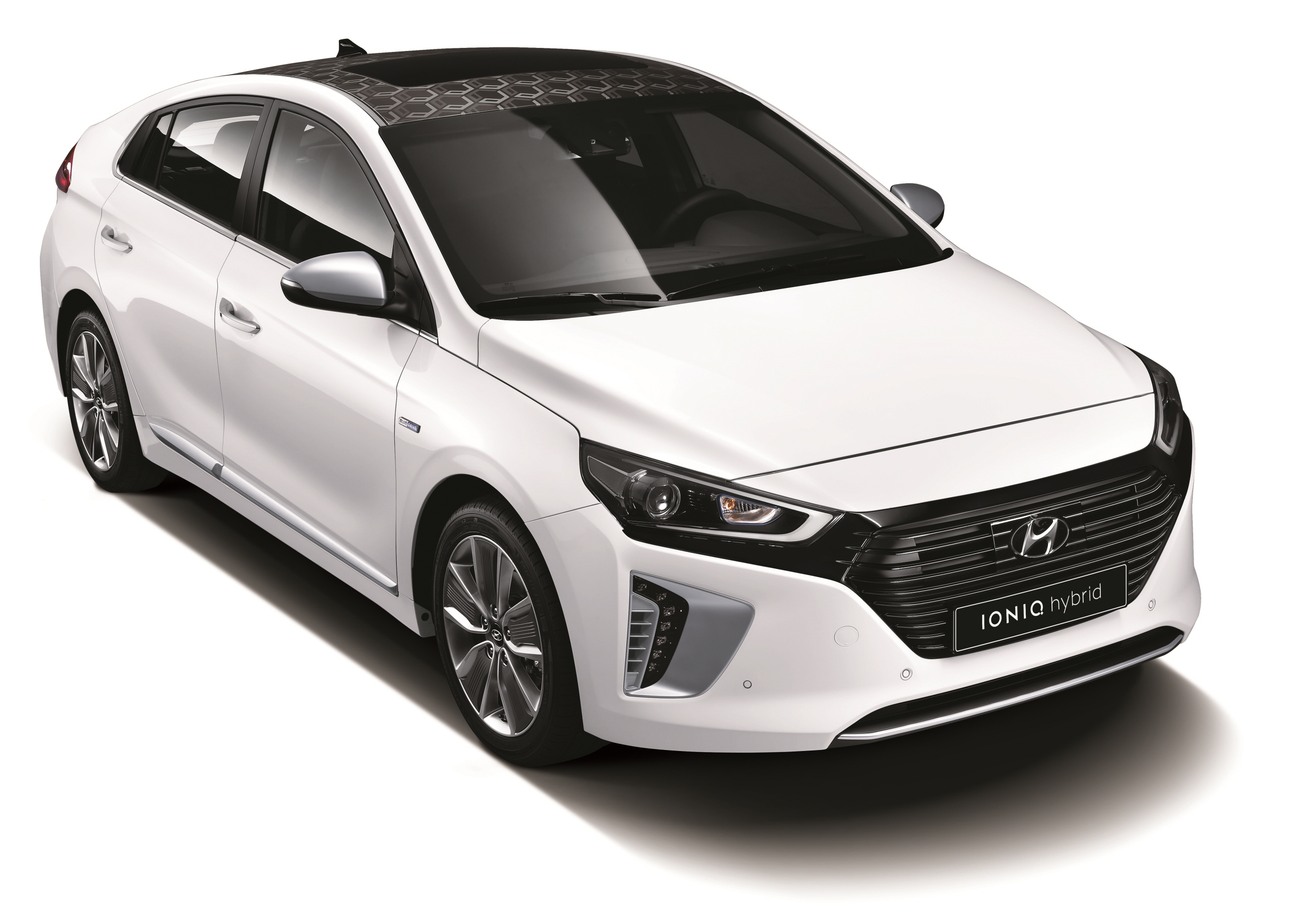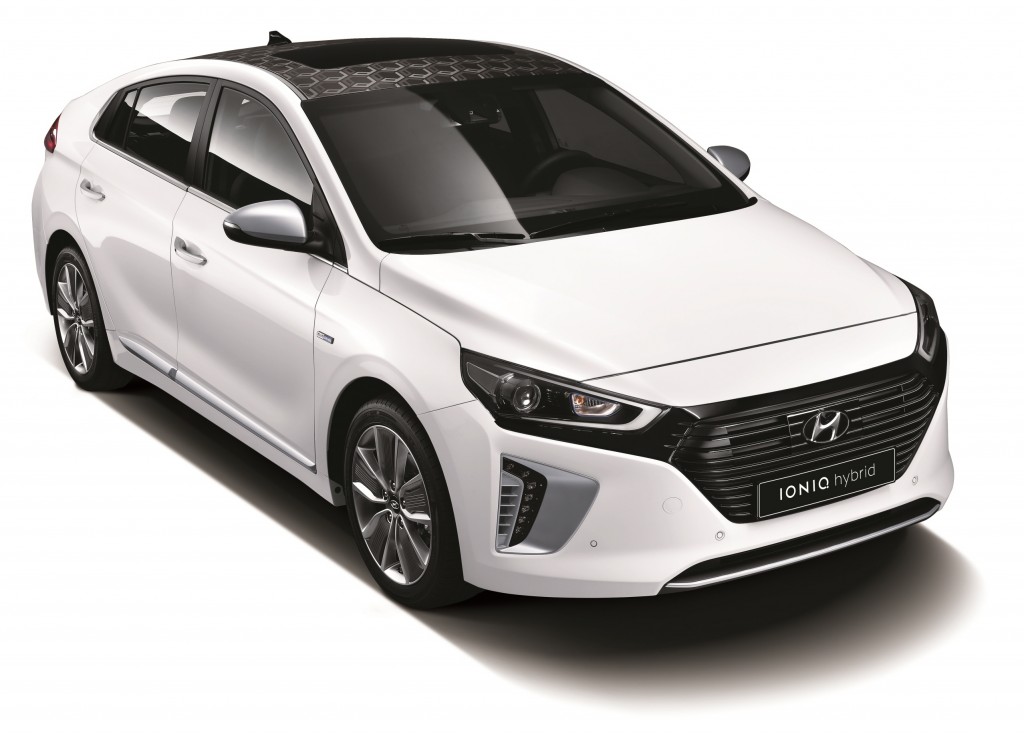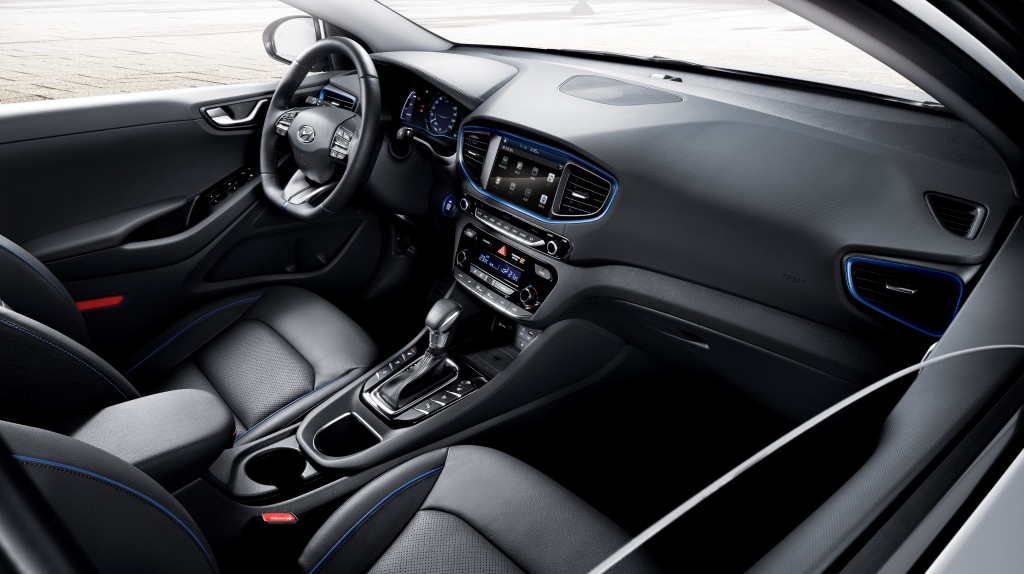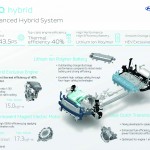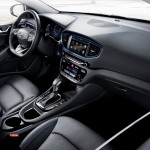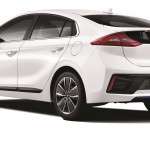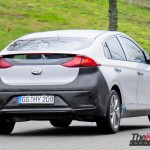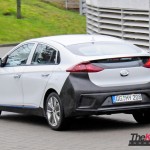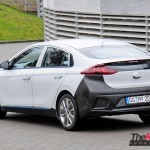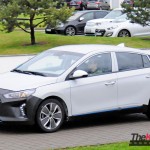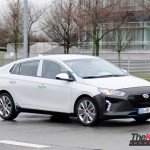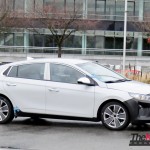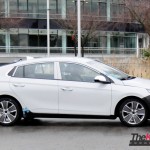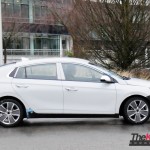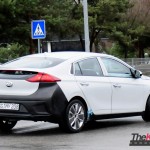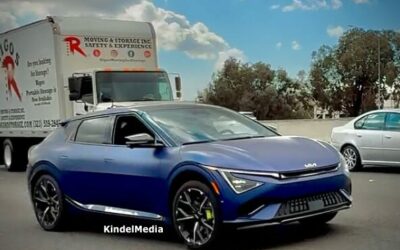Hyundai Motor Company, South Korea’s largest automaker, has unveiled the IONIQ, its advanced, alternative-fuel compact vehicle due for launch in 2016. The car will be available with an electric, plug-in gasoline/electric hybrid (HEV), or gasoline/electric hybrid powertrain, with the IONIQ Hybrid variant the first to come to market.
[ads id=”0″ style=”float:left;padding:9px;”]“The launching event announced the start of new future mobility and our will for technological innovation to the world. Hyundai Motor will spearhead efforts to become the global number two in the green car market by introducing over 22 models in the eco-friendly car line-up by 2020,” said Moon-Sik Kwon, Vice Chairman at Hyundai Motor R&D Center. “IONIQ has been developed incorporating all of our technological capacities. The hybrid, pursuing the highest efficiency in its class, is economically efficient and stays true to the fundamentals of a car by delivering the fun to drive through a modern design and dynamic driving performance,” he added.
The IONIQ Hybrid responds to rapidly changing customer lifestyles by breaking the mold for hybrid vehicles as it not only offers class-leading fuel efficiency but also a fun, responsive drive and attractive design, a unique mix not yet achieved by a hybrid vehicle.
The IONIQ Hybrid is equipped with a newly developed, dedicated 1.6 GDI four-cylinder Kappa engine and a 32kW (43.5PS) electric motor, which is fed by an advanced Lithium-Ion polymer battery. The two powertrains have combined maximum output of 103.6kW (141PS) and 27kg.m (265Nm) of torque. A newly developed six-speed dual-clutch transmission (6DCT) provides responsive performance and a slick gear shift, resulting in an entertaining drive, and good fuel economy.
The IONIQ’s coupe-like silhouette is streamlined to manage airflow, this characteristic combines with active and passive aero features to help it achieve an outstanding Cd-value of just 0.24, making it one of the most aerodynamic cars on the market.
To suit customers’ varied lifestyles, the IONIQ also offers a host of advanced comfort, convenience, safety connectivity features, including Apple CarPlay and Android Auto, catering for the vast majority of smartphone users. A 7-inch TFT information cluster brings a high-tech appearance to the cockpit, displaying a range of digital gauges in high resolution, including a number of hybrid-specific displays.
Based on an exclusive new platform, the driving performance of the IONIQ is similar to that of a regular compact car, thanks to its responsive hybrid powertrain. Ride and handling as well as noise, vibration and harshness levels are specially tuned to contribute to a superior ride quality as well as being quiet and comfortable on long journeys.
To complement the IONIQ’s long list of high-tech features, a host of innovative future-ready active and passive safety features protect the driver and passenger. Electronic systems like Autonomous Emergency Brake, Lane Keeping Assist System / Lane Departure Warning System, and a Blind Spot Detection with Rear Cross Traffic Alert provide guidance to avoid any accident. Seven airbags including a knee-airbag for the driver, as well as structural body enhancements, enabled by adapting 53% of the body with Advanced High Strength Steel, gives the IONIQ’s chassis superior rigidity for responsive handling and enhanced safety.
The new car’s name references elements of its creation. An ion is an electrically-charged atom, linking to the car’s clever combination of electrified powertrains. The second part of the name references the unique offering it brings to the Hyundai range, demonstrating the brand’s environmental commitment and willingness to maximize choice for its customers. Finally, the Q is depicted in the car’s logo as a visual breakthrough, acknowledging the fresh new approach of this advanced, low-emission model.
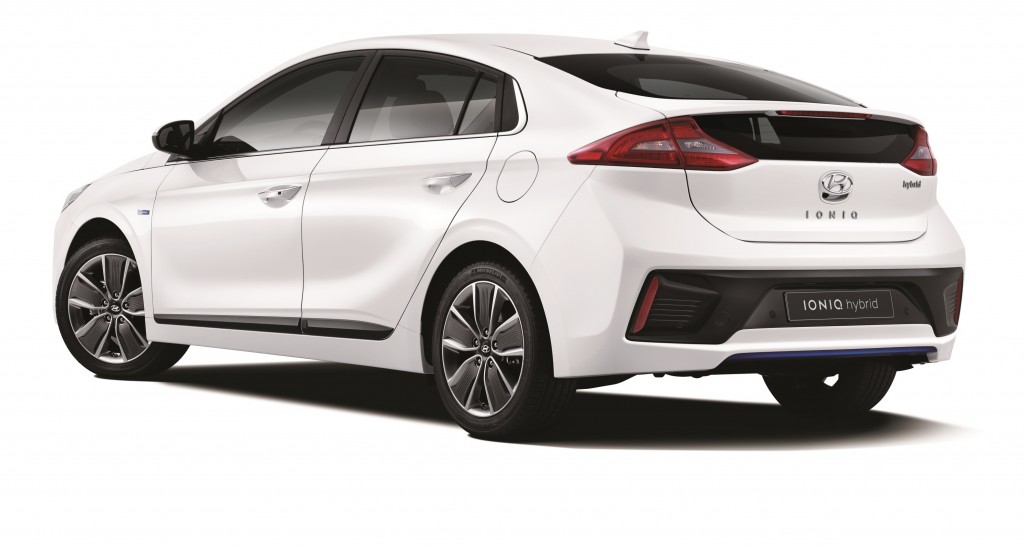
[ads id=”0″ style=”float:left;padding:9px;”]01 Styling: Eco-friendly meets high-tech
The IONIQ calls upon two key influences – efficiency and technology – in its design, which combine to create a unique and future-looking appearance. Throughout the IONIQ’s development, engineers and designers worked hand-in-hand to ensure that form and function evolved simultaneously.
These eco-friendly and high-tech aims are met consistently throughout the IONIQ, while the joined-up development process influences the attractive styling of the car more than any other rival as form and function combine seamlessly. The IONIQ’s distinguished exterior design sets the model apart from other hybrid electric vehicles as the styling builds the car’s high-tech features into its design, emphasizing the model’s eco-friendly image.
Exterior Design
In crafting the exterior appearance of the IONIQ, Hyundai Motor’s designers concentrated on the car’s future-orientated character, which is at the heart of its appeal.
A fluid exterior shape and natural air flow channels emphasize the aerodynamic body lines and volumes that communicate the IONIQ’s eco-friendly credentials while also conveying its performance abilities. A sporty, hatchback-like profile sets the IONIQ apart from other hybrid models with the car’s distinguished exterior design contributing to its attractive styling.
The IONIQ’s sleek exterior shape is inspired by aerodynamic efficiency complementing the soft lines and surfaces that trace the car’s outline. Its exterior panels are designed to flex to boost aerodynamics further, which, when combined with various other smart efficiency solutions, produces class-leading Cd-value of just 0.24.
In addition to the IONIQ’s supple body shape, further design details contribute towards Hyundai Motor’s aim of achieving an eco design matching high levels of technology. At the front of the car, the refined shape of the headlights and Hyundai Motor’s signature hexagonal grille visually depict the purity of IONIQ as an eco-friendly car. Contrasting colors at the base of the bumper add a special flair, while nine exterior colors are available and can be paired with a choice of three interior options. A unique radiator grille, with HID headlights set above C-shaped LED light distinguishes the front of the car, while specially-designed 15/17-inch wheels differentiate the hybrid vehicle from its electric and plug-in hybrid siblings.
Interior Design
Just as with the car’s exterior design, the interior of the IONIQ captures the model’s futuristic perspective and draws on the car’s eco-friendly and hybrid credentials. A ‘Purified High-Tech’ concept was established, which then evolved into the refined interior of the IONIQ.
A recurring smooth, elegant and clutter-free theme meets a warm feeling inside the IONIQ as efficient use of interior space complements a logical, structured approach applied to the layout of controls. Eco-friendly materials are used to create a simple and clean look throughout the car, giving the interior a spacious, sleek, light and purified feel.
[ads id=”0″ style=”float:left;padding:9px;”]02 Powertrains – Efficient and ultra-low emission
Developed to strive for the world’s highest hybrid fuel efficiency without compromising the driving performance, the IONIQ Hybrid is equipped with a newly developed, dedicated 1.6 GDI four-cylinder Kappa engine. The 1.6 GDI powerplant delivers 77kW (105PS) at 5,700rpm while providing maximum torque of 15.0kg.m (147Nm) at 4,000rpm. It is combined with a newly developed, very efficient six-speed dual-clutch transmission (6DCT) and, in collaboration with the 32kW (43.5PS) electric motor, offers a maximum output of 103.6kW (141PS) at 5700rpm and 27.0kg.m (265Nm) of torque in first gear 24.0kgf.m / 235Nm in second to sixth.
The IONIQ Hybrid outperforms all other hybrid electric competitors in this segment while still providing a fun, responsive drive, an attractive design and comprehensive state of the art convenience features.
Six-speed dual-clutch transmission
The IONIQ Hybrid and Plug-in hybrid both feature a six-speed dual-clutch transmission (6DCT), which boasts best-in-class transfer efficiency through the use of low-friction bearings and low-viscosity transmission oil.
Capitalizing on the latest generation of transmission technology, the IONIQ achieves its unique mix of driving performance and excellent fuel efficiency through intelligently set gear ratios combined with a sophisticated shift strategy, which transfers power smoothly from gear to gear.
Differentiating itself from other hybrid cars, which are often criticized for ‘rubber band-like’ acceleration, the sporty and fun to drive IONIQ uses its 6DCT to engage the driver and harness the electric and combustion technologies to best effect.
Enhancing further the car’s fuel efficiency and dynamic driving characteristics, the driver can also select SPORT or ECO modes. The SPORT function holds lower gears longer and combines power from the engine and electric motor to reward the driver with maximized performance. In ECO mode, the 6DCT optimizes the gear selection for fuel economy, shifting up earlier to higher gears to achieve class-leading fuel economy.
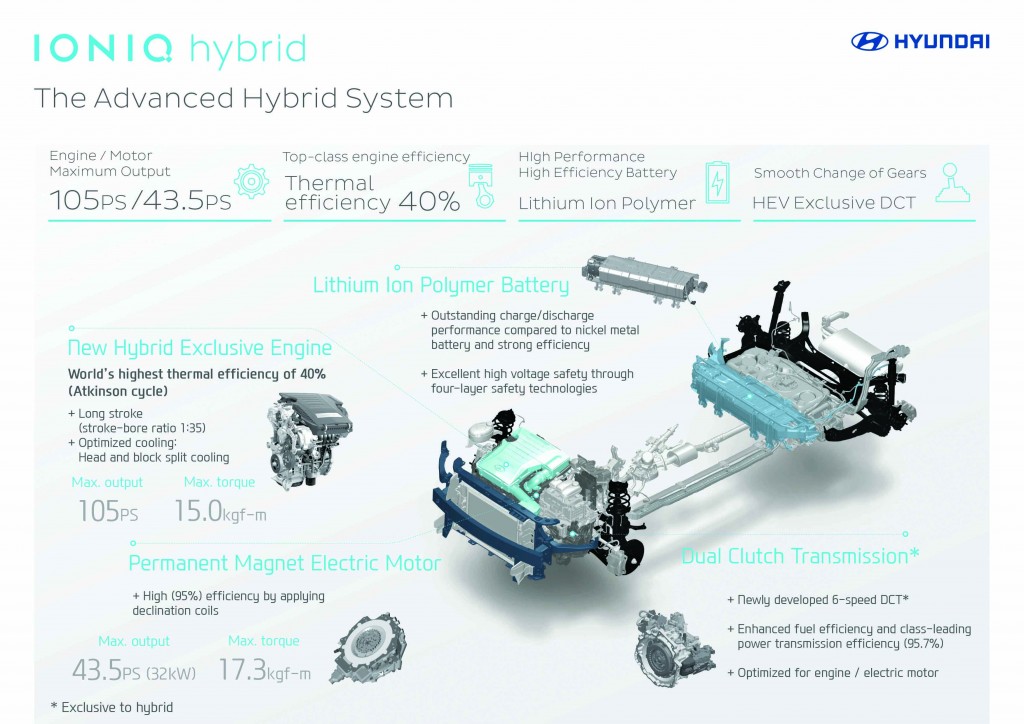
Compact and powerful electric motor
The 1.6 GDI engine is accompanied by a 32kW (43.5PS) electric motor, which also adds another 17.3kg.m (170Nm) to the system at maximum output. It enables the IONIQ Hybrid to operate in pure electric mode at speeds up to 120kph, maximizing efficiency and minimizing CO2 emissions.
The electric power is generated by a permanent magnet synchronous motor and was specifically developed for world-class efficiency. To achieve this, parts of the motor were optimized by reducing the thickness of core components (electrical steel sheet) by up to 10% and adopting rectangular-section copper wire to decrease core and copper loss.
Lithium-Ion polymer battery
Hyundai Motor engineers decided to use a Lithium-Ion polymer battery pack for the IONIQ Hybrid – instead of conventional nickel-metal-hydride batteries. This provides lower memory sensitivity, excellent charge / discharge efficiency and an outstanding maximum output. Efficient packaging was also taken into consideration as the battery system is located underneath the rear seats so that the usability of the passenger cabin and cargo area is entirely uncompromised.
The complete set of hybrid powertrain components was designed to be very compact and highly efficient. The combined extra weight of the hybrid technology therefore only adds minimal additional weight to the IONIQ but, significantly increases its efficiency.
[ads id=”0″ style=”float:left;padding:9px;”]03 Advanced engineering and technology – Setting IONIQ apart
IONIQ’s engineers did not only focus on making the powertrain as efficient as possible, they set out to create a car that excelled in design, comfort and convenience of infotainment. Applying the latest technologies and engineering techniques to these areas enhances the IONIQ’s appeal and elevates its status against competitors.
Aerodynamic
IONIQ’s sleek, coupe-like silhouette and its simple, carefully wrought contours assist the efficient management of airflow around the exterior. Additional applications like front wheel air curtains, an external active air flap, a rear spoiler and diffuser, side sill moldings, floor undercover and a closed wheel design all contribute to the car’s efficiency in its goal to offer the world’s best hybrid fuel efficiency.
Comfort and convenience
To provide a pleasant, comfortable and refreshing climate in the car without using unnecessary amounts of energy, IONIQ’s climate control can be switched to an efficient operation mode. Due to a maximum utilization of the inside air when air-conditioning or heating, ventilation losses can be minimized and the overall efficiency of the system increases. Also, the dual-zone climate control can be set to ‘driver only’ mode, reducing the load of the air-conditioning and heating to work more efficiently.
Another Hyundai-first and a key characteristic of the IONIQ is its innovative use of recycled materials or eco-friendly materials. For example, the interior door covers are made from recycled plastic combined with powdered wood and volcanic stone. While providing the same quality appearance and noise damping performance, the weight is reduced by 20% compared to conventional cladding material.
The softer, more natural feel is achieved alongside less reliance on oil-based products. The eco-consciousness extends to other areas of the car too. Raw materials extracted from sugar cane are partly applied on the headlining and carpet helping to improve quality of air inside the car and the recyclability of vehicle parts at end of life. Eco-friendly paint with ingredients extracted from soybean oil are used to achieve lustrous metallic colors on some of the components.
ECO-DAS
The ECO-DAS (Eco-Driving Assistant System) set-up makes best use of several unique technologies in order to make the IONIQ as efficient as possible. ECO-DAS assesses the driving route set in the satellite navigation system and current traffic levels. The system enables the most efficient battery charging or extra motor assistance as required by the predicted road conditions.
The advanced system encourages efficient coasting by informing the driver of changes in speed limit or road conditions, allowing the car to travel the same distance, in the same time, without the need for harsh acceleration or braking. This utilization of key technologies and smart driving processes ultimately improves fuel efficiency while also optimizing battery capacity and lengthening the electric range deliverable from a single charge.
Infotainment
To suit customers’ varied lifestyles, the IONIQ features state-of-the-art infotainment and connectivity features. The IONIQ is equipped with a new generation high-resolution 7-inch TFT-information cluster. With a resolution of 1280×720 pixels, it displays all types of gauges (speedometer, ECO, state of charge, fuel etc.) including hybrid-specific displays like the current system operation or status. Depending on the selected drive mode, background color and gauges are adapted to always provide the most important and useful information as well as In fa relaxed or sporty atmosphere through the colors used.
The IONIQ will cater for drivers looking to integrate their smart phone with the vehicle’s infotainment system by providing both Apply CarPlay and Android Auto. Both systems enable users to connect their devices to deliver and control music, telephone or navigation functions on screen. The seamless connectivity allows drivers and passengers to stay connected while remaining focused on the road. To ensure occupants’ phones are always charged, IONIQ also offers a wireless inductive charging pad (Qi standard) for mobile phones, set among the other cutting-edge features inside the car.
Weight reduction
One of the main questions throughout every single development step of the IONIQ was, where weight could be cut without compromising the goal to also create a fun-to—drive and comfortable car. The IONIQ uses aluminum in the hood and tailgate, which reduces weight by 12.4kg compared to the conventional steel option without any disadvantages in noise or vibration. The weight loss strategy also extended to less obvious areas like the cargo-screen cover. Due to a higher usage of light-weight components and a more compact optimized build, the cargo-screen cover of the IONIQ is around 25% lighter than the version used in other Hyundai models.
[ads id=”0″ style=”float:left;padding:9px;”]04 Driving Performance – Efficient mobility without compromise
Driving performance of the IONIQ is better than any hybrid car in its class thanks to its hybrid powertrain, which is specially adapted for the IONIQ to deliver efficient mobility without compromise. Ride and handling, as well as noise, vibration and harshness levels, are specially tuned to contribute towards superior ride quality, while insulation in the dash minimizes engine noise. Damping in the floor panels as well as enhanced A- and B-pillar fillings, thicker window glass and noise cancelling film on the windshield further improve the quiet and comfortable ride.
A sporty gear shift is achieved with the six-speed dual-clutch transmission, which adds to the ‘fun to drive’ element and overall pleasure of driving the IONIQ. The 6DCT helps maintain the model’s exciting driving sensation and can be switched from the pre-set ECO mode into SPORT mode, rewarding the driver with later gear shifts and using more engine power to maximize performance.
The application of a multi-link rear suspension system with dual lower arm enhances ride comfort while a proportionately large use of aluminum for front and rear suspension components saves around 10kg of weight compared to conventional means. A reduction of 2.3kg per front lower arm unit saves 4.6kg at the front of the car, while 7.14kg is saved at the IONIQ’s rear with each unit shedding 3.57kg.
Responsiveness and feedback from the steering system is clear and precise, with an increased steering gear ratio that helps to compound the IONIQ’s sporty and responsive feel while reinforcing the car’s ‘fun to drive’ character.
Braking force is optimized to get the most out of the hybrid system’s regenerative braking system, in turn helping the IONIQ maintain a healthy state of charge (SOC). The regenerative braking system also operates to reduce noise, using the third generation of the brand’s energy recuperating stopping system. An Integrated Brake Assist Unit (iBAU) and Pressure Source Unit (PSU) also contribute to quieter operation than competitors. This also helps ensure ultra-low friction for maximum energy recuperation and efficiency.
A collaboration with tire manufacturer Michelin gives IONIQ enhanced levels of efficiency as the car is fitted with low rolling resistance tires for better fuel economy, plus the car’s larger 17-inch wheels are fitted with silica tires for better performance. The multi-link suspension system has been adapted in order to work most efficiently with low rolling resistance tires.
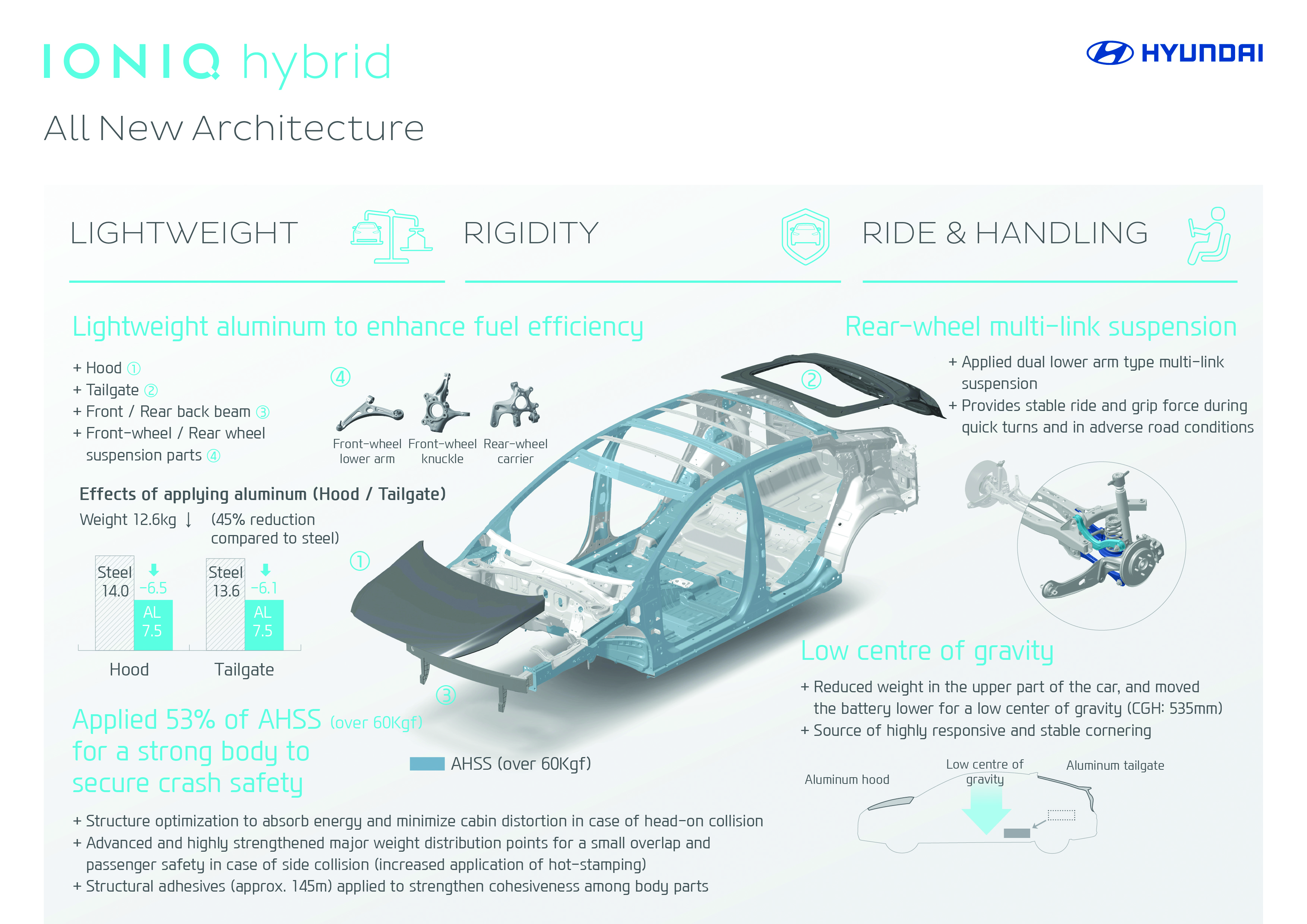
05 Comfort and convenience – Top-class comfort, trend-setting convenience
The IONIQ delivers great driver and passenger convenience, bringing to the segment a range of considerations that other dedicated hybrid vehicles may have compromised on in the past.
All hybrid components of IONIQ are cleverly packaged to not compromise space, flexibility or usability of the interior. In fact, IONIQ offers best-in-class cargo space by positioning the hybrid’s battery underneath the rear seats. Moreover, the rear seats can fold flat providing a cargo space of up to 750 liters, allowing large pieces of luggage to be stowed with ease, plus flexible daily usability.
It also offers great front and rear headroom, plus comprehensive shoulder and leg room in the front and back, while a memory function driver’s seat and heated front and rear seats invite occupants for a relaxing ride.
[ads id=”0″ style=”float:left;padding:9px;”]06 Safety – Innovative active and passive safety features
The IONIQ boasts a light yet rigid body as a result of advanced design, construction methods and materials. Featuring 53% Advanced High Strength Steel, the IONIQ’s chassis benefits from superior rigidity for responsive handling and is extremely safe, with high impact energy absorption and minimized distortion to protect passengers in the event of a collision.
To complement the IONIQ’s long list of advanced convenience technologies, a host of innovative future-ready active and passive safety features protect the driver and passengers. These electronic assistive systems are class-leading as IONIQ continues to break the mold for hybrid vehicles.
The long list of active safety features includes Blind Spot Detection, which works directly alongside Lane Change Assist and Blind Spot Detection with Rear Cross Traffic Alert to warn the driver of any surrounding vehicles, passengers or other objects that may lead to a collision if unnoticed while the car is in motion.
A Lane Departure Warning System (LDWS) and Lane Keeping Assist System (LKAS) are of use when driving on the highway. The systems alert the driver if unsafe movements are made while the car is driving by sensing the car’s position in relation to highway lanes. The LDWS sounds an alarm before the car moves over white lines on the road, while the LKAS warns the driver acoustically and visually before inducing corrective steering to guide the driver back to a safe position.
The car is also fitted with an Autonomous Emergency Braking (AEB) system, an advanced active safety feature that alerts drivers to emergency situations, braking autonomously if required. Using front radar and camera sensors, AEB operates in three stages. Initially warning the driver visually and acoustically, it controls the brake according to the collision danger stage, and applies maximum braking force right before the moment of collision. When a vehicle or pedestrian is sensed in front of the IONIQ, the system is activated, operating at speeds of 10km/h or above and minimizes damage when a collision is unavoidable.
Using front radar sensors, Smart Cruise Control allows a constant speed and distance to be maintained from the vehicle ahead without depressing the accelerator or brake pedals, it is automatically cancelled when the speed of the car drops to 10kph or below. Additionally, a Tire Pressure Monitoring System ensures the IONIQ’s tires are always suitably inflated.
Around the interior of the IONIQ, a total of seven airbags are available. Including a knee airbag for the driver, they are placed to protect the vehicle’s occupants in the event of a collision. Body structure improvements to the car mean it is strong and durable in the event of a crash – complemented by a high-strength fiber-reinforced rear bumper.

